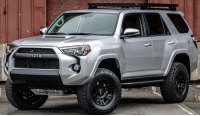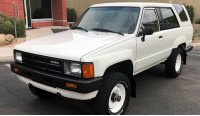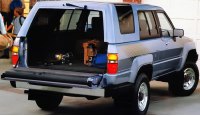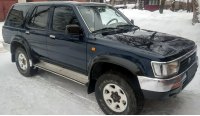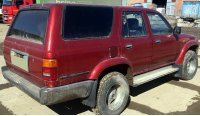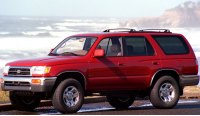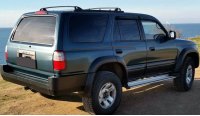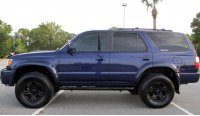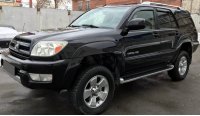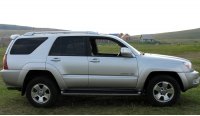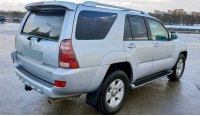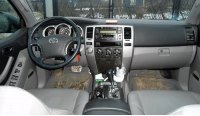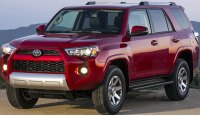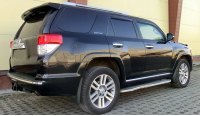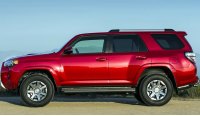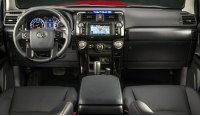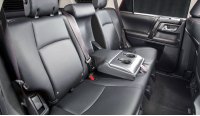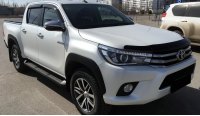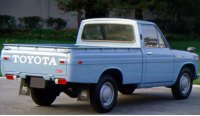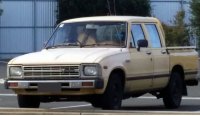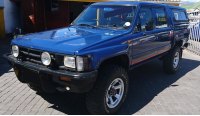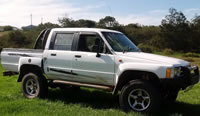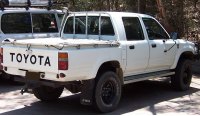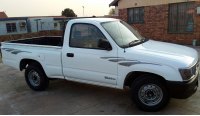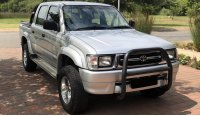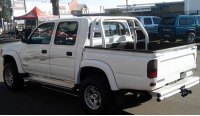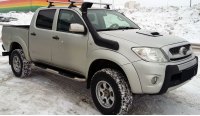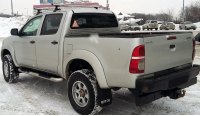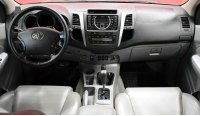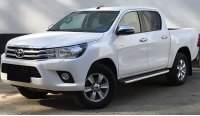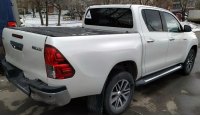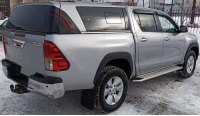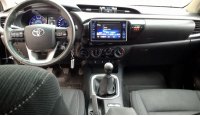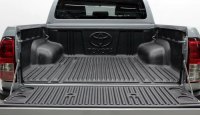Share information:
Toyota 4Runner (1983-present time)
Toyota 4Runner — mid-size SUV with a supporting frame (J segment), which is manufactured by the Japanese Automobile Corporation «Toyota Motor» from 1983 to the present. Until 1995, it belonged to the class of compact SUVs. In Japan it is called «Toyota Hilux Surf». Based on the pickup truck already in production since 1968 «Toyota Hilux» (see description below) and has the same technical part with it. This car has a brother very similar in characteristics and dimensions, but cheaper and less durable «Highlander». The engine is located in front longitudinally with all-wheel drive. There are simplified models with rear-wheel drive. Word «runner» translated from English as «runner», and the number «4» indicates all-wheel drive. A similar vehicle has been sold in Southeast Asia since 2005 «Toyota Fortuner». Production of all generations was only in Japan.
Close classmates and competitors «4Runner» are currently Audi Q7, BMW X5, Ford Explorer, Kia Sorento, Honda Pilot, Jeep Cherokee, Hyundai Santa Fe, Land Rover Discovery, Lexus GX, Mitsubishi Outlander, Mercedes-Benz M-Class, Mazda CX-9, Porsche Cayenne, Nissan Pathfinder, Nissan Murano, Peugeot 4008, Renault Koleos, Skoda Kodiaq, Suzuki Grand Vitara, Toyota Land Cruiser Prado, And Volkswagen Touareg.
First generation (N60, 1984-1989)
First generation production «4 Runner» series «N60» started in October 1983 based on a pickup truck «Hilux» fourth generation, slightly changing it. The changes affected only the rear of the cars - they removed the wall behind the front seats, installed rear seats and a removable fiberglass roof. The mechanical part remained unchanged. Some cars were sold without rear seats. The body turned out to be a three-door station wagon with a length of 4435 mm, a width of 1689 mm, a height of 1679 mm, a wheelbase of 2616 mm and a curb weight of 1597-1706 kg. The front suspension was spring dependent with a continuous axle, the rear was leaf spring with a torsion beam. The engine was located longitudinally in front, the drive is full with the connection of the front wheels.
The engines were petrol four-cylinders of the following 2.0 liter models (1998 cm3, 3Y, I4, OHV, 87 hp), 2.4 liters (2366 cm3, 22R/22R-E, I4, SOHC, 97 hp), 2.4 liters (2366 cm3, 22R-TE, I4, SOHC, turbocharged, 135 hp), as well as a six-cylinder V-shaped volume of 3.0 liters (2958 cm3, 3VZ-E, V6, DOHC, 150 hp). Diesel engines were presented in two modifications - 2.4 liters (2446 cm3, 2L, I4, SOHC, 83 hp) and 2.4 liters (2446 cm3, 2L-T, I4, SOHC, turbocharged, 90 hp). The transmission is a five-speed manual or four-speed automatic.
In 1986, the front suspension underwent major improvements - instead of a continuous axle, it became independent with a slightly increased track. This had a positive effect on the handling and comfort of the car, but slightly reduced off-road patency. Also changed the grille. There were a few more minor changes in 1988.
Second generation (N120/N130, 1989-1995)
In August 1989, the production of the second generation of the series began «N120» and «N130» as a 1990 model year. Pickup also served as the basis «HiLux», but with a completely new one-piece steel body instead of a fiberglass lid. Apart from the new body, all mechanical parts were from the pickup, except for the rear suspension, which became spring instead of spring. The body was a three-door or five-door station wagon with the same external dimensions - wheelbase 2624 mm, length 4470-4490 mm, width 1690 mm, height 1680 mm, curb weight 1750 kg. The tailgate opened down like a pickup truck, instead of opening the door up like most other competitors of the time.
Gasoline engines were 2.0 liter four-cylinder (1998 cm3, 3Y, I4, OHV 87 hp), 2.2 liters (2237 cm3, 4Y, I4, OHV, 94 hp) and 2.4 liters (2366 cm3, 22R-E, I4, SOHC, 109 hp) or six-cylinder V-shaped with a volume of 3.0 liters (2958 cm3, 3VZ-E, V6, DOHC, 150 hp) and 3.4 liters (3378 cm3, 5VZ-FE, V6, DOHC, 175 hp). There were four diesel engines, all four-cylinder in-line, the following modifications - 2.4 liters (2446 cm3, 2L-TE, SOHC, turbocharged, 96 hp), 2.4 liters (2446 cm3, 2L-TII, SOHC, turbocharged, 93 hp), 2.8 liters (2779 cm3, 3L, SOHC, 90 hp) and 3.0 liters (2982 cm3, 1KZ-T/TE, SOHC, turbocharged, 125/130 hp). The transmission was a five-speed manual or four-speed automatic «A340H».
In 1991, they carried out a cosmetic update that affected the front bumper and modular headlights. The second update was in 1993.
Third generation (N180, 1995-2002)
Production of the third generation of the series «N180» started in August 1995. The body and chassis were completely redesigned and had nothing to do with the pickup «HiLux», since that time they have been one with «Land Cruiser Prado». The move moved the car into a different class of mid-size SUV, more luxurious and expensive, but the exterior remained similar to the second generation. The body was only a five-door station wagon with a wheelbase of 2675 mm. The length of the car increased over the period of production of this generation from 4539 mm to 4656 mm, the width was 1689 mm, the height also increased from 1689 mm to 1714 mm. The curb weight was 1730 kg. The enlarged body brought increased cabin and cargo space.
There were three models of engines - a 2.7-liter gasoline four-cylinder (2693 cm3, 3RZ-FE, I4, DOHC, 150 hp), gasoline six-cylinder V-shaped 3.4 liters (3378 cm3, 5VZ-FE, V6, DOHC, 190 hp) and diesel four-cylinder 3.0 liters (2982 cm3, 1KZ-TE, I4, SOHC, turbocharged, 130 hp). The gearbox was a five-speed manual or four-speed automatic.
Standard equipment includes dual airbags, an upward opening tailgate, anti-lock braking system (ABS), spring suspension on all wheels, center differential first appeared.
In 1997 and 1998, minor updates were made to the interior, cabin and equipment. In 1999, they carried out a strong update of the appearance and improvement of the interior. The ergonomics of the cabin has been completely changed, moving all controls to the center of the dashboard, the dashboard has become a digital odometer. In 2001, the taillights became transparent, the grille, rims and climate control design were changed. Electronic stability control became a standard feature.
Fourth generation (N210, 2002-2009)
The fourth generation appeared in August 2002 and was based on the platform «Prado 120». The body and chassis have been heavily redesigned, the exterior design has changed little. The body was a five-door station wagon, the wheelbase increased and amounted to 2789 mm. The length of the car was 4806 mm, width 1875-1910 mm, height 1750-1811 mm and curb weight 1941 kg. Available finishes and configurations were called «SR5», «Sport Edition» and «Limited». It is still sold in Japan under the name «Hilux Surf», but in 2009 this name will be cancelled.
There were no more four-cylinder gasoline engines, V-shaped ones were installed - a six-cylinder with a volume of 4.0 liters (3956 cm3, 1GR-FE, V6, 236 hp) and two eight-cylinder 4.7-liter (4663 cm3, 2UZ-FE, V8, 232 hp) and 4.7 liters (4663 cm3, 2UZ-FE, V8, VVT-i, 271 hp). Diesel engines were two four-cylinder 3.0-liter (2982 cm3, 1KZ-TE, I4, SOHC, turbocharged, 130 hp) and 3.0 liters (2982 cm3, 1KD-FTV, I4, DOHC, 170 hp). Gearboxes remained only automatic four-speed «Aisin A3xx» or five-speed «Aisin A7xx».
The front suspension is spring-loaded with two wishbones, the rear spring-loaded with a continuous solid axle. Air suspension with automatic height adjustment was offered as an option. System «X-REAS» connects the dampers diagonally with hydraulic hoses and fluid, using a mechanical center valve that reduces body roll during tight turns. Auxiliary control system «Hill-Start» prevents the vehicle from rolling backwards on slopes when starting off, and there is also a low speed hill descent assist system.
Standard features and equipment were a height and tilt adjustable steering wheel, keyless entry, single zone automatic climate control, power driver's lumbar support, power tailgate window, on V8 models a tow hitch. Additional options included «HomeLink» (remote control system), electrochromic auto-dimming rear view mirror, power sunroof, third row of seats, navigation system based on «DVD», stereo system «JBL Synthesis» with 10 speakers and an audio system in the back seat, an additional backup camera.
Standard driver assistance and safety systems included anti-lock brakes, electronic brake force distribution, brake assist, traction control, electronic vehicle stability control, side thorax airbags for the front seats, and side curtain airbags for the front and rear rows..
American agency «National Highway Traffic Safety Administration» (NHTSA) conducted crash tests on a 2003 car, the results were as follows:
- frontal impact (driver) — 4 out of 5 stars
- frontal impact (passenger) — 4 out of 5 stars
- Side kick (driver) — 5 out of 5 stars
- Side kick (rear passenger) — 5 out of 5 stars
- Roof strength - 3 out of 5 stars
Almost every year this generation was released, updates were made to the appearance and equipment of the model.
Fifth generation (N280, 2009-present time)
In September 2009, the fifth generation was introduced «4 Runner» series «N280». The body was a five-door station wagon, attached to a solid frame. Based on an SUV platform «FJ Cruiser». The length of the car was 4823 mm, width 1925 mm, height 1816-1885 mm, wheelbase 2789 mm and curb weight 1996-2180 kg. All-wheel drive, there are models with rear-wheel drive only. Trim and trim levels were «SRW», «Trail Edition» and «Limited». The following systems were installed to improve off-road patency - an advanced traction control system «A-TRAC», dynamic suspension system «KDSS», system for driving at low speed on difficult terrain «Crawl Control» and locking rear differential.
Engines were installed only gasoline, one four-cylinder in-line with a volume of 2.7 liters (2693 cm3, 2TR-FE, DOHC, VVT-i, 158 hp) and a second six-cylinder V-shaped 4.0 liter (3956 cm3, 1GR-FE, DOHC, VVT-i, 236 hp). Gearboxes are only automatic four- or five-speed.
In 2013, the model was updated - the front and rear of the car were updated, projection headlights were installed in the front, transparent LED lights in the back, the interior trim, dashboard and instrument cluster were changed.
In 2015, an American non-profit organization «Insurance Institute for Highway Safety» (IIHS) car crash tested «4Runner», the results are as follows:
- Frontal impact with partial overlap - Good
- Low Overlap Frontal Impact - Ultimate
- Side kick - good
- Roof strength - Good
Toyota HiLux (1968-present time)
Toyota Hilux - a mid-size pickup truck with a supporting frame, produced from 1968 to the present by a Japanese company «Toyota Motor». Until 2004, he fell into the class of compact pickups. The engine is located longitudinally in front, the drive was first on the rear wheels, and since 1978 an all-wheel drive version has appeared. The body was both a two-door and a four-door pickup truck with a full interior. There was also a body in the form of a cab on the chassis, allowing the end user to install the equipment he needs himself. In the US, the car was called «Toyota Pickup» and «Toyota Truck», and since 1995 it has been replaced by a pickup truck «Tacoma». In 1984 «Hilux» formed the basis of an SUV «4Runner» (see description above), which at first was based entirely on the chassis and body of a pickup truck, and from the third generation began to be assembled on the chassis «Land Cruiser Prado».
The engine is located longitudinally in front, the drive was first rear-wheel drive, and from the third generation it became full with the front wheels connected. At the present time, the main classmates and competitors «Toyota Hilux» are the following pickups from other manufacturers - Fiat Fullback, Ford Ranger, Great Wall Wingle, Mazda BT-50, Mercedes-Benz X-Class, Mitsubishi L200, Nissan Navara, Renault Alaskan, SsangYong Actyon Sport, UAZ Patriot Pickup, Volkswagen Amarok.
First generation (N10, 1968-1972)
Production of the Hilux began in March 1968. It was originally a frame-mounted, two-door, two-seater, with a longitudinal engine at the front, with rear-wheel drive only. The wheelbase was long and short. With a long wheelbase, the car was 4690 mm long, with a short one - 4300 mm. The width was 1610 mm, height 1560-1565 mm, curb weight 1050-1085 kg. The car was designed and built by «Hino Motors» to replace an obsolete pickup truck «Hino Briska». The front suspension was spring, rear continuous drive axle on leaf springs.
Engines only gasoline four-cylinder of the following characteristics - 1.5 liters (1490 cm3, 2R, SOHC, 74 hp), 1.6 liters (1587 cm3, 12R, OHV, 89 hp), 1.9 liters (1858 cm3, 8R, SOHC, 109 hp), 1.9 liters (1897 cm3, 3R, SOHC, 79 hp) and 2.0 liters (1968 cm3, 18R, SOHC, 105 hp). A four-speed manual transmission was on all variants of the cars.
Second generation (N20, 1972-1978)
The second generation appeared in May 1972 with the chassis code «N20». The body was the same two-door double with a short (N20, 2580 mm) and long (N25, 2795 mm) wheelbase. The length of the car was 4275-4680 mm, width 1580 mm, height 1580 mm and curb weight 1090 kg. The interior has become much more comfortable. In the US, some companies began to make motor homes based on this pickup truck.
The engines were all 1.6 liter four-cylinder petrols (1587 cm3, 12R, OHV, 83 hp), 2.0 liters (1968 cm3, 18R, SOHC, 109 hp) and 2.2 liters (2189 cm3, 20R, SOHC, 97 hp).. The gearbox was a four- or five-speed manual, and for the first time they began to install a three-speed automatic.
Third generation (N30/N40, 1978-1983)
In August 1978, the third generation of the Hilux pickup was introduced. The body was a two-door with a double saloon (code N30) with a wheelbase of 2585 mm, a length of 4300 mm, a width of 1610 mm, a height of 1565 mm and a curb weight of 1055 kg. For the first time they began to offer a four-door body with a four-seat interior (code N40) with a wheelbase of 2800 mm, a length of 4690 mm, a width of 1610 mm, a height of 1565 mm and a curb weight of 1055 kg. The engine was located longitudinally in front, rear-wheel drive. In January 1979, all-wheel drive models began to be offered.
Petrol engines were still four-cylinder with the following parameters:
- 1.6 liters (1587 cm3, 12R, I4, SOHC) 79 hp
- 2.0 liters (1968 cm3, 18R, I4, SOHC) 88 hp
- 2.2 liters (2189 cm3, 20R, I4, SOHC) 90 hp
- 2.4 liters (2366 cm3, 22R, I4, SOHC) 97 hp
For the first time, a 2.2-liter diesel engine was installed (2188 cm3, L, I4, SOHC) 62 hp. Gearboxes were the same as the previous generation. Transfer case «RF1A» in all-wheel drive vehicles had a lower gear.
For the US market in 1983, a luxury pickup truck was released «Mojave» with chrome bumpers, bucket seats, cruise control, power steering and air conditioning.
Fourth generation (N50/N60/N70, 1983-1988)
In August 1983, the fourth generation Hilux began to be sold. The body was a two-door double or a four-door four-seater. There were three wheelbases - the usual 2616 mm (vehicle length 4435 mm, width 1621 mm, height 1544-1709 mm), extended 2845 mm (vehicle length 4729 mm, width 1621 mm, height 1534-1709 mm), as well as extra long «Xtracab» 3086 mm (vehicle length 4966 mm, width 1689 mm, height 1532-1704 mm). The curb weight was 1270 kg. Based on this generation of the car, an SUV was created «4Runner» (see description above). The front suspension has become independent, torsion bar, double wishbone with anti-roll bar. The rear suspension has not changed.
Gasoline engines were mostly four-cylinders, but for the first time one six-cylinder V-shaped was added:
- 1.6 liters (1626 cm3, 1Y, I4, OHV) 83 hp
- 2.0 liters (1998 cm3, 3Y I4, OHV) 89 hp
- 2.4 liters (2366 cm3, 22R, I4, SOHC) 97 hp
- 2.4 liters (2366 cm3, 22R-E, I4, SOHC, injection) 105 hp
- 2.4 liters (2366 cm3, 22R-TE, I4, SOHC, turbo, injection) 135 hp
- 3.0 liters (2958 cm3, 3VZ-E, V6, DOHC) 145 hp
Diesel engines were three models with a volume of 2.2 liters (2188 cm3, L, I4, 71 hp), 2.4 liters (2446 cm3, 2L, I4, 76 hp) and 2.4 liters (2446 cm3, 2L-T, I4, turbocharged, 90 hp). The transmission was a four- or five-speed manual, as well as a three- or four-speed automatic.
At the end of 1986, the pickup truck underwent a minor interior and exterior upgrade, which affected the grille and front bumper.
Fifth generation (N80/N90/N100/N110, 1988-1997)
The fifth generation appeared in August 1988. There were also three different wheelbases - the usual (2616 mm), elongated (2850 mm) and extra long «Xtracab» (3089 mm). The body is available in three versions - two-door double 4435 mm long, 1690 mm wide, 1544-1750 mm high; two-door quadruple «Xtracab» 4905 mm long, 1690 mm wide, 1549-1755 mm high; four-door four-seater 4910 mm long, 1690 mm wide, 1539 mm high. The engine is located in front longitudinally, the drive is rear or full on all wheels. American Automobile Magazine «Motor Trend» gave a pickup truck with a cab «Xtracab» rank «Car of the Year» in 1988. The car was assembled in Japan, Argentina, Germany, Colombia, New Zealand, USA, Thailand and the Philippines. German concern «Volkswagen» produced and sold «Hilux» under the name «Volkswagen Taro» from February 1989 to March 1997.
There were three models of petrol engines, two four-cylinder 1.8 liters (1812 cm3, 2Y/2Y-U, OHV, I4, 82/78 hp), 2.4 liters (2366 cm3, 22R-E, SOHC, I4, injection, 113 hp) and one V-shaped six-cylinder with a volume of 3.0 liters (2958 cm3, 3VZ-E, DOHC, V6, injection, 150 hp). Diesel engines two models, both four-cylinder 2.4-liter (2446 cm3, 2L-II, SOHC I4, 89 hp) and 2.8 liters (2779 cm3, 3L, SOHC, I4, 90 hp). The transmission was a four- or five-speed manual or a four-speed automatic.
In 1991, they carried out a minor facelift, changing the grille and emblem. In 1995 and the USA «Hilux» replaced with a new pickup truck «Tacoma».
Sixth generation (N140/N150/N160/N170, 1997-2005)
The sixth generation also has a body built on three different wheelbases - the usual (2850 mm), elongated (2855 mm) and extra long «Xtracab» (3089 mm). Cabins are also three options - two-door double (length 4690 mm, width 1665 mm, height 1775 mm), two-door quadruple (length 4975 mm, width 1790 mm, height 1775 mm) and four-door quadruple (length 1730 mm, width 1790 mm, height 1795 mm). The engine is still located in front longitudinally, the drive is full or rear. The assembly was carried out in Venezuela, Colombia, Thailand, the Philippines and Japan. This is the latest generation made in Japan.
The petrol engines were mainly four-cylinder in-line, as well as one six-cylinder, all with electronic injection of the following characteristics:
- 2.0 liters (1998 cm3, 1RZ-E, SOHC, I4) 108 hp
- 2.4 liters (2438 cm3, 2RZ-FE, DOHC, I4) 142 hp
- 2.7 liters (2693 cm3, 3RZ-FE, DOHC, I4) 150 hp
- 3.4 liters (3378 cm3, 5VZ-FE, DOHC, V6) 190 hp
Diesel engines were two models of 2.4 liters (2446 cm3, 2L-T, I4, turbo) 82 hp and 3.0 liters (2986 cm3, 5L, I4, turbo) 97 hp. The gearbox was a four-speed automatic or a five-speed manual.
In 1998, a small batch of SUVs was released to Asian markets «Hilux Sport Rider» with a station wagon.
In 2001, a minor update of the model was carried out.
Seventh generation (AN10/AN20/AN30, 2004-2015)
The seventh generation began production in August 2004. The car is based on a new platform «Toyota IMV» with regular 2750mm and extended 3085mm base. A minivan is assembled on the same platform «Innova» and crossover «Fortuner». The body was a two-door double (length 4980 mm, width 1760 mm, height 1795-1810 mm), two-door quadruple «Xtra» (length 5135-5260 mm, width 1885 mm, height 1695-1810 mm) and four-door four-seater (length 4980-5260 mm, width 1885 mm, height 1695-1810 mm). The curb weight was 1555-1770 kg. The drive is still full or only rear. The car was assembled in Argentina, Venezuela, Malaysia, Pakistan, Thailand and South Africa.
Gasoline engines were represented by the following models:
- 2.0 liters (1998 cm3, 1TR-FE, I4) 134 hp
- 2.7 liters (2693 cm3, 2TR-FE, I4) 160 hp
- 4.0 liters (3956 cm3, 1GR-FE, V6) 228 hp
- 4.0 liters (3956 cm3, 1GR-FE, V6, turbo) 302 hp
All four-cylinder diesel engines are represented by three models with a volume of 2.5 liters (2494 cm3, 2KD-FTV, 102 hp), 2.5 liters (2494 cm3, 2KD-FTV, turbocharged, 143 hp) and 3.0 liters (2982 cm3, 1KD-FTV, turbocharged, 162 hp). The transmission was a five-speed manual or four- and five-speed automatic.
The first update was carried out in 2008. The second update of the exterior and interior was carried out in 2011.
Eighth generation (AN120/AN130/AN30, 2015-present time)
Sales of the eighth generation Hilux began in October 2015. Based on a proven platform «Toyota IMV» with one wheelbase 3085 mm. The body is represented only by a four-door four-seat double cab with a length of 5335 mm, a width of 1855 mm, a height of 1815 mm and a curb weight of 2095 kg. The front suspension is spring independent, the rear dependent spring with a continuous axle. The engine is located in front longitudinally, rear-wheel drive or all-wheel drive. The car was assembled in Argentina, Pakistan, Thailand and South Africa.
Gasoline engines are represented by three models with a volume of 2.0 liters (1998 cm3, 1TR-FE, I4, 139 hp), 2.7 liters (2693 cm3, 2TR-FE, I4, 158 hp) and 4.0 liters (3956 cm3, 1GR-FE, V6, 236 hp). The diesel engines were all turbocharged four-cylinders:
- 2.4 liters (2393 cm3, 2GD-FTV) 150 hp
- 2.5 liters (2494 cm3, 2KD-FTV) 102 hp
- 2.5 liters (2494 cm3, 2KD-FTV, intercooler) 144 hp
- 2.8 liters (2755 cm3, 1GD-FTV) 177 hp
- 3.0 liters (2982 cm3, 1KD-FTV) 163 hp
- 3.0 liters (2986 cm3, 5L-E) 95 hp
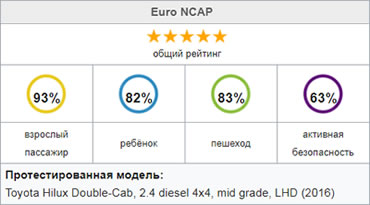
In 2016 the European Committee «Euro NCAP» conducted crash tests to determine the safety, see the results in the table on the right.
In November 2017, the updated car was shown at the 34th International Automobile Exhibition in Thailand.

